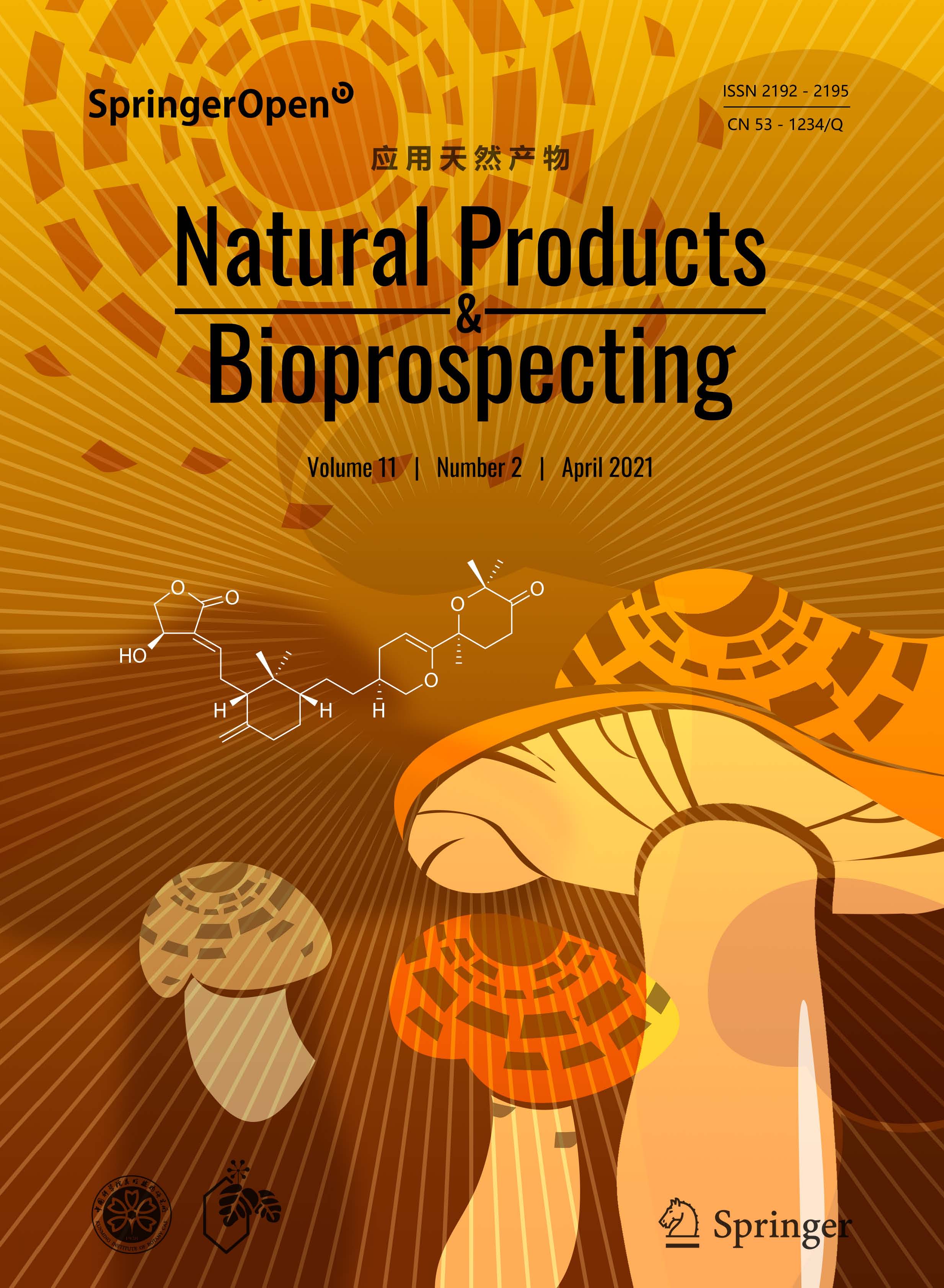|
|
Plants Used as Antihypertensive
Collect
Tarawanti Verma, Manish Sinha, Nitin Bansal, Shyam Raj Yadav, Kamal Shah, Nagendra Singh Chauhan
Natural Products and Bioprospecting. 2021, 11 (2): 155-184.
DOI: 10.1007/s13659-020-00281-x
Hypertension is a critical health problem and worse other cardiovascular diseases. It is mainly of two types:Primary or essential hypertension and Secondary hypertension. Hypertension is the primary possibility feature for coronary heart disease, stroke and renal vascular disease. Herbal medicines have been used for millions of years for the management and treatment of hypertension with minimum side effects. Over aim to write this review is to collect information on the anti-hypertensive effects of natural herbs in animal studies and human involvement as well as to recapitulate the underlying mechanisms, from the bottom of cell culture and ex-vivo tissue data. According to WHO, natural herbs/shrubs are widely used in increasing order to treat almost all the ailments of the human body. Plants are the regular industrial units for the invention of chemical constituents, they used as immunity booster to enhance the natural capacity of the body to fight against different health problems as well as herbal medicines and food products also. Eighty percent population of the world (around 5.6 billion people) consume medicines from natural plants for major health concerns. This review provides a bird's eye analysis primarily on the traditional utilization, phytochemical constituents and pharmacological values of medicinal herbs used to normalize hypertension i.e. Hibiscus sabdariffa, Allium sativum, Andrographis paniculata, Apium graveolens, Bidenspilosa, Camellia sinensis, Coptis chinensis, Coriandrum sativum, Crataegus spp., Crocus sativus, Cymbopogon citrates, Nigella sativa, Panax ginseng,Salviaemiltiorrhizae, Zingiber officinale, Tribulus terrestris, Rauwolfi aserpentina, Terminalia arjuna etc.
References |
Related Articles |
Metrics
|
|
|
Identification and Bioactivities of Secondary Metabolites Derived from Endophytic Fungi Isolated from Ethnomedicinal Plants of Tujia in Hubei Province: A Review
Collect
Ke Ye, Hong-Lian Ai, Ji-Kai Liu
Natural Products and Bioprospecting. 2021, 11 (2): 185-205.
DOI: 10.1007/s13659-020-00295-5
Tujia is a national minority, inhabiting in the mountainous Wuling area in China. Since 1978, Tujia medicine has been studied, summarized and developed, leading to numerous achievements by Chinese researchers, such as the publishing of approximately 30 monographs of Tujia medicine. These publications are focused on summarizing and improving the theory of Tujia medicine and developing clinical therapies from this system of medicine. The shortage of natural medicinal plants used in Tujia medicine has created the need to discover new resources to replace them and protect endangered natural plant species. Endophytic fungi are one of the conservation options, are considered a source of new bioactive natural products, and are a renewable and inexhaustible source of new drugs and agrochemicals. This review summarizes 260 compounds from endophytic fungi that have been previously isolated from the medicinal plants of Tujia. These compounds include steroids, terpenoids, meroterpenoids, polyketides, alkaloids, peptides, aliphatic compounds, aromatic compounds, and heterocyclic compounds.
References |
Related Articles |
Metrics
|
|
|
Bousmekines A-E, New Alkaloids from Two Bousigonia Species: B.angustifolia and B. mekongensis
Collect
Zong-Qing Huo, Qian Zhao, Wen-Tao Zhu, Xiao-Jiang Hao, Yu Zhang
Natural Products and Bioprospecting. 2021, 11 (2): 207-213.
DOI: 10.1007/s13659-020-00278-6
Four new monoterpenoid indole alkaloids, bousmekines A-D (1-4), and one new pyranopyridine alkaloid, bousmekine E (5), were isolated from the twigs and leaves of Bousigonia angustifolia and Bousigonia mekongensis. Their structures including absolute configurations were elucidated by a combination of MS, NMR, ECD calculation, and single-crystal X-ray diffraction analysis. Compound 2 was an eburnea-type MIAs characterized by a rare chlorine atom while 5 possessed a novel pyranopyridine moiety. Their cytotoxicities against several human cancer cell lines were evaluated and compound 1 exhibited significant cytotoxicity with IC50 values of 0.8-7.4 μM.
References |
Related Articles |
Metrics
|
|
|
Identification of Anxiolytic Potential of Niranthin: In-vivo and Computational Investigations
Collect
Atul R. Chopade, Prakash M. Somade, Pratik P. Somade, Suraj N. Mali
Natural Products and Bioprospecting. 2021, 11 (2): 223-233.
DOI: 10.1007/s13659-020-00284-8
Anxiety is an unpleasant state, which can critically decrease the quality of life is often accompanied by nervous behaviour and rumination. Niranthin is a lignan isolated from various Phyllanthus sources. The literature survey on niranthin highlights wide ranges of the therapeutic potentials. In a present study, based on our previous investigations, we evaluated pure, isolated and characterized niranthin as an anxiolytic agent. The niranthin[6-[(2R,3R)-3-[(3,4-dimethoxyphenyl)methyl]-4-methoxy-2-(methoxymethyl)butyl]-4-methoxy-1,3-benzodioxole] was purchased from commercial source and further subjected for assessment of its anxiolytic potentials using popular animal models including Elevated plus-maze model/test (EPM) and Light & Dark Exploration test (L&D). GABA-A receptor mediation was evaluated by pretreating the mice with the GABAA receptor antagonist Flumazenil before the EPM task. Molecular docking simulation studies (pdb id:4COF) carried out by Vlife QSAR software showed that niranthin (docking score:-62.1714 kcal/mol) have shown comparatively best docking score compared to the standard drug Diazepam (docking score:-63.1568 kcal/mol). To conclude, Niranthin has probable potential in the management of anxiety disorder. Our in-silico and in-vivo analysis (indirectly) indicated the plausible role of GABA mediation for anxiolytic activity. Although, these studies are preliminary, future in depth experimental explorations will be required to use Niranthin as anti-anxiety drug in near future.
References |
Related Articles |
Metrics
|
|
|
Structures, Chemical Conversions, and Cytotoxicity of Tricholopardins C and D, Two Tricholoma Triterpenoids from the Wild Mushroom Tricholoma pardinum
Collect
Chen Shi, Yue-Ling Peng, Juan He, Zheng-Hui Li, Ji-Kai Liu, Tao Feng
Natural Products and Bioprospecting. 2021, 11 (2): 235-241.
DOI: 10.1007/s13659-021-00297-x
Two undescribed Tricholoma triterpenoids, namely tricholopardins C (1) and D (2), were isolated from the wild mushroom Tricholoma pardinum. Their structures with absolute configurations were elucidated by spectroscopic methods, as well as the single crystal X-ray diffraction. Compounds 1 and 2 were further obtained by chemical conversions from the known analogues. Compound 1 showed significant cytotoxicity to MCF-7 and Hela cell lines with IC50 values of 4.7 μM and 9.7 μM, respectively. Its mechanism of inducing MCF-7 cell apoptosis was studied briefly.
References |
Related Articles |
Metrics
|
|

